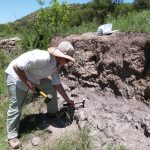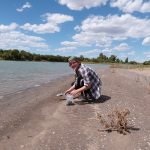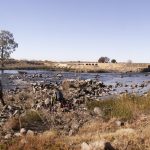Reconstruir la historia del impacto de meteoritos en la Luna podría traer luz sobre un evento que jugó un papel fundamental en lo que significó el establecimiento de la Tierra como planeta habitable.
Así lo explica el doctor Aaron J. Cavosie en su trabajo más reciente A terrestrial perspective on using ex situ shocked zircons to date lunar impacts, que realizó en coautoría con Timmons M. Erickson, Stephanie D. Montalvo y Maya R. Pincus, estudiantes graduados del Departamento de Geología del Recinto Universitario de Mayagüez (RUM).
El artículo que aparecerá en la edición de noviembre de la revista Geology, de la Sociedad Geológica de América, informa la dificultad de determinar la fecha de impacto de meteoritos en la Tierra utilizando el mineral circón; por esta razón, los resultados de la investigación cuestionan cuán bien se entiende la historia del impacto de meteoritos en la Luna basada en datos de circones lunares.
“Given the controversial nature of the subject matter, I think this article will likely generate broad interest, as it questions the timing constraints on one of the most fundamental processes in the inner Solar System, the early impact bombardment”, auguró Cavosie.
“When times are tough, it’s helpful to remind people through media why science is worth funding”, agregó el experto en petrología, geoquímica y mineralogía.
Actualmente el doctor Cavosie, profesor adjunto del Departamento de Geología del RUM, radica en Australia, donde funge como investigador en el Departamento de Geología Aplicada de la Universidad de Curtin.
Para acceder al artículo del doctor Cavosie en la revista Geology, pulse aquí.
- UPRM graduate student Maya Pincus, sampling rocks inside the giant Vredefort Dome impact structure in South Africa to search for shocked zircons (2014).
- UPRM alumnus Stephanie Montalvo (MS, 2015) sampling sediment from the Orange River in South Africa, to search for ex situ shocked zircons.
- UPRM alumnus Timmons Erickson (MS, 2012) sampling modern sediment from the Vaal River in South Africa, to search for ex situ shocked zircons.
- Dr. Aaron Cavosie, Adjunct Professor in the UPRM Department of Geology.
Suministradas
Questioning the lunar impact history
(By Aaron J. Cavosie)
Reconstructing the meteorite impact history of the Moon is critical for constraining the timing, duration, and flux of the early impact bombardment of the inner Solar System, which played a first-order role in establishing when Earth became habitable. The U-Pb ages of zircons in lunar breccias have been interpreted as dating impacts on the Moon, however, a new study by Cavosie et al. questions these ages, as most lunar zircons do not show evidence of shock deformation caused by impact. To test the validity of dating impacts using zircons that have been separated from their source rocks, the authors studied detrital shocked zircons in modern sediments eroded from the giant 2.0 billion year old Vredefort impact in South Africa. The detrital shocked zircons are a terrestrial analog for lunar breccia zircons, as both zircon populations have been separated from their host rocks. Electron backscatter diffraction was used to identify diagnostic shock microstructures caused by impact, such as microtwins, however, these features did not result in age-resetting during impact. Only rare neoblasts, regions of newly recrystallized zircon, yielded the impact age. These results demonstrate that most lunar zircons record crystallization ages, rather than impact ages, and thus can’t be used to reconstruct an accurate impact chronology for the Moon.
Figure 1. Examples of ex situ zircons on the Earth and Moon.
A. Shock-deformed zircons eroded from the 2 billion-year-old Vredefort Dome impact structure are found as grains of sand in the Vaal River, South Africa. Detrital shocked zircons can be identified by the unique fracturing caused by meteorite impact (see inset), even after they have been separated from their source rocks. Most detrital shocked zircons record the age of the rocks in which they crystallized, in this case ~ 3 billion years ago, rather than the 2 billion-year-old age of the Vredefort impact event (image credit: Aaron J. Cavosie).
B. Deformed lunar zircon (center of image) in an Apollo 17 impact breccia. Zircons in lunar breccias are similar to detrital shocked zircons in the sense that they have been separated from their source rocks. The fracturing and damage uniquely caused by meteorite impact has not been reported in most lunar zircons, a finding which suggests that ages in many lunar zircons may record magmatic processes, rather than dating impacts (image credit: Nicholas E. Timms).
 Figure 2. Detrital shocked zircon from the Vredefort Dome, South Africa. An electron backscatter diffraction image of a polished shocked zircon, where the smooth background color scheme shows angular variations in crystal orientation that record damage caused by impact (an undamaged crystal would be all one color). The thin red bands are microtwins (labelled t1-t4), which occur in four different orientations (see arrows) and are a unique hallmark of meteorite impact. Four U-Pb age determinations made on this highly shocked grain yielded the age of rocks exposed at the Vredefort impact structure, not the impact age (image credit: Aaron J. Cavosie).
Figure 2. Detrital shocked zircon from the Vredefort Dome, South Africa. An electron backscatter diffraction image of a polished shocked zircon, where the smooth background color scheme shows angular variations in crystal orientation that record damage caused by impact (an undamaged crystal would be all one color). The thin red bands are microtwins (labelled t1-t4), which occur in four different orientations (see arrows) and are a unique hallmark of meteorite impact. Four U-Pb age determinations made on this highly shocked grain yielded the age of rocks exposed at the Vredefort impact structure, not the impact age (image credit: Aaron J. Cavosie).
Suministradas











